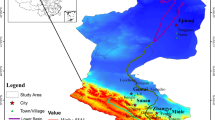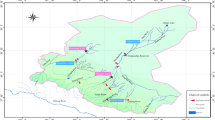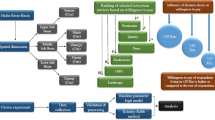Abstract
The growing appreciation of distance decay as an important parameter necessary for estimating willingness to pay (WTP) is hugely recognized in the literature. In this paper, we estimated the extent to which distance decay and individual’s socioeconomic characteristics influence the WTP for restoration of environmental quality attributes in the Heihe River Basin. A choice experiment technique was used to evaluate the household’s WTP for the improvements in local environmental attributes. The results of mixed logit model significant impact of distance on the individual’s WTP for the improvements in environmental attributes. Findings of the study revealed that people living within 25 km from the river are willing to pay more for an increase in the river water quality level, a reduction in sandstorm days, and an increase in the area of the east Juyan Lake than the people living within the range of 50 km and much more compared to 50 km away from the river. Based on the socioeconomic characteristics, it is concluded that the level of education, age, household’s annual income, and household size have a significant effect on the WTP. Results of the implicit prices for each attribute showed the preferences of the inhabitants for every attribute, where the highest WTP in pooled data was recorded for river water quality level (i.e., RMB 124.81/year) and the lowest for leisure and entertainment (i.e., RMB 0.40/year). The highest WTP for water quality suggests that water quality level was the most favored attribute compared to others, subject to the given conditions of water quality and the river basin.





Similar content being viewed by others
References
Agee MD, Crocker TD (2010) Directional heterogeneity of environmental disamenities: the impact of crematory operations on adjacent residential values. Appl Econ 42:1735–1745
Alberini A, Cropper M, Fu T-T, Krupnick A, Liu J-T, Shaw D, Harrington W (1997) Valuing health effects of air pollution in developing countries: the case of Taiwan. J Environ Econ Manag 34:107–126
Asioli D, Almli VL, Næs T (2016) Comparison of two different strategies for investigating individual differences among consumers in choice experiments. A case study based on preferences for iced coffee in Norway. Food Qual Prefer 54:79–89
Bach MF, Beckmann MJ (1999) Lectures on location theory. Springer Science & Business Media, Berlin
Bateman IJ, Langford IH (1997) Budget-constraint, temporal, and question-ordering effects in contingent valuation studies. Environ Plan A 29:1215–1228
Bateman IJ, Day BH, Georgiou S, Lake I (2006) The aggregation of environmental benefit values: welfare measures, distance decay and total WTP. Ecol Econ 60:450–460
Bateman IJ, Brouwer R, Ferrini S, Schaafsma M, Barton DN, Dubgaard A, et al. (2009) Making benefit transfers work: deriving and testing principles for value transfers for similar and dissimilar sites using a case study of the non-market benefits of water quality improvements across Europe. CSERGE working paper EDM
Bateman IJ, Brouwer R, Ferrini S, Schaafsma M, Barton DN, Dubgaard A, Hasler B, Hime S, Liekens I, Navrud S, de Nocker L, Ščeponavičiūtė R, Semėnienė D (2011) Making benefit transfers work: deriving and testing principles for value transfers for similar and dissimilar sites using a case study of the non-market benefits of water quality improvements across Europe. Environ Resour Econ 50:365–387
Brouwer R, Martin-Ortega J, Berbel J (2010) Spatial preference heterogeneity: a choice experiment. Land Econ 86:552–568
Campbell D, Hutchinson WG, Scarpa R (2009) Using choice experiments to explore the spatial distribution of willingness to pay for rural landscape improvements. Environ Plan A 41:97–111
Carson RT, Louviere JJ, Wei E (2010) Alternative Australian climate change plans: the public’s views. Energy Policy 38:902–911
Concu GB (2010) Investigating distance effects on environmental values: a choice modelling approach. Aust J Agric Resour Econ 51:175–194
Czajkowski M, Budziński W, Campbell D, Giergiczny M, Hanley N (2017) Spatial heterogeneity of willingness to pay for forest management. Work Pap 68:1–23
Dare AM (2014) Rural households’ access, willingness to pay (WTP) and factors influencing WTP for safe water and sanitation in Southwest Nigeria
Do NT, Bennett J (2007) Willingness-to-Pay for wetland improvement in Vietnam’s Mekong River Delta. Canberra: Australian Agriculture and Resource Economics Society
Espey M, Owusu-Edusei K (2001) Neighborhood park and residential property values in Greenville, South Carolina. J Agric Appl Econ 33:487–492
Georgiou S, Bateman I, Cole M, Hadley D (2000) Contingent ranking and valuation of river water quality improvements: testing for scope sensitivity, ordering and distance decay effects. CSERGE GEC Working Paper
Ghosh S, Maitra B, Das SS (2013) Effect of distributional assumption of random parameters of mixed logit model on willingness-to-pay values ☆. Procedia Soc Behav Sci 104:601–610
Greene WH (2003) Econometric analysis. Prentice Hall, New Jersey, p 16
Hanley N, Schläpfer F, Spurgeon J (2003) Aggregating the benefits of environmental improvements: distance-decay functions for use and non-use values. J Environ Manag 68:297–304
Hatton MacDonald D, Crossman ND, Mahmoudi P, Taylor LO, Summers DM, Boxall PC (2010) The value of public and private green spaces under water restrictions. Landsc Urban Plan 95:192–200
Hensher, D. 2007. Reducing sign violation for vtts distributions through endogenous recognition of an individual's attribute processing strategy. International Journal of Transport Economics 34:333-349.
Hogue C (2010) Clearing the water. Chem Eng News 78:31
Hole AR, Kolstad JR (2012) Mixed logit estimation of willingness to pay distributions: a comparison of models in preference and WTP space using data from a health-related choice experiment. Work Pap Econ 42:445–469
Imber D, Wilks L, Stevenson, G, Australia. Resource Assessment Commission (1991). A contingent valuation survey of the Kakadu Conservation Zone. Published for the Resource Assessment Commission by the Australian Govt. Pub. Service, Canberra
Jørgensen SL, Olsen SB, Ladenburg J, Martinsen L, Svenningsen SR, Hasler B (2013) Spatially induced disparities in users’ and non-users’ WTP for water quality improvements—testing the effect of multiple substitutes and distance decay. Ecol Econ 92:58–66
Kaffashi S, Shamsudin MN, Radam A, Rahim KA (2015) Socio-economic reason to save an international wetland. J Integr Environ Sci 12:67–83
Khan I, Zhao M (2019) Water resource management and public preferences for water ecosystem services: a choice experiment approach for inland river basin management. Sci Total Environ 646:821–831
Khan I, Zhao M, Khan SU (2018) Ecological degradation of an inland river basin and an evaluation of the spatial and distance effect on willingness to pay for its improvement. Environ Sci Pollut Res 25:31474–31485
Khan I, Khan SU, Zhao M, Khan AA (2019a) Exploring the spatial heterogeneity of individual preferences for integrated river basin management: an example of Heihe River Basin. Environ Sci Pollut Res 1–11
Khan SU, Khan I, Zhao M, Khan AA, Ali MAS (2019b) Valuation of ecosystem services using choice experiment with preference heterogeneity: a benefit transfer analysis across inland river basin. Sci Total Environ 679:126–135
Kong F, Yin H, Nakagoshi N (2007) Using GIS and landscape metrics in the hedonic price modeling of the amenity value of urban green space: a case study in Jinan City, China. Landsc Urban Plan 79:240–252
Konishi Y, Coggins JS (2008) Environmental risk and welfare valuation under imperfect information. Resour Energy Econ 30:150–169
Lancaster KJ (1966) A New Approach to consumer theory. J Polit Econ 74:132–157
Library WP (2017) National Bureau of Statistics of China
Loomis JB (1996) How large is the extent of the market for public goods: evidence from a nationwide contingent valuation survey. Appl Econ 28:779–782
Louviere JJ (2001) Choice experiments: an overview of concepts and issues. The choice modelling approach to environmental valuation 13–36
Luo K, Tao F, Moiwo JP, Xiao D (2016) Attribution of hydrological change in Heihe River Basin to climate and land use change in the past three decades. Sci Rep 6:33704
Mark M, Jeff B (2004) Valuing New South Wales rivers for use in benefit transfer. Aust J Agric Resour Econ 48:591–611
Mazur K, Bennett JW (2008) Choice modelling in the development of natural resource management strategies in NSW
Ozdemiroglua E, Newcombea J, Mouratob S, Atkinsonc G, Degarisd Y (2004) The value of a Tidier Thames: WTP to reduce sewage overflows. Applied Environmental Economics Conference, The Royal Society
Pate J, Loomis J (1997) The effect of distance on willingness to pay values: a case study of wetlands and salmon in California. Ecol Econ 20:199–207
Poor PJ, Boyle KJ, Taylor LO, Bouchard R (2001) Objective versus subjective measures of water clarity in Hedonic property value models. Land Econ 77:482–493
Ruud P (1996) Approximation and simulation of the multinomial probit model: an analysis of covariance matrix estimation. Department of Economics, Berkeley 1–17
Schaafsma M, Brouwer R, Rose J (2012) Directional heterogeneity in WTP models for environmental valuation. Ecol Econ 79:21–31
Schaafsma M, Brouwer R, Gilbert A, van den Bergh J, Wagtendonk A (2013) Estimation of distance-decay functions to account for substitution and spatial heterogeneity in stated preference research. Land Econ 89:514–537
Sutherland RJ, Walsh RG (1985) Effect of distance on the preservation value of water quality. Land Econ 61:281–291
Tait P, Baskaran R, Cullen R, Bicknell K (2011) Valuation of agricultural impacts on rivers and streams using choice modelling: a New Zealand case study. N Z J Agric Res 54:143–154
Tanrivermi, H., 1998. Willingness to pay (WTP) and willingness to accept (WTA) measures in Turkey: May willingness to pay and willingness to accept be indicators to share the environmental damage burdens: A case study, Journal of Economic Cooperation among Islamic Countries, Vol. 19, No. 3, pp. 67-93.
Train KE (2009) Discrete choice methods with simulation. Cambridge University Press, Cambridge
Turner RK, Georgiou S, Clark R, Brouwer R, Burke JJ (2004) Economic valuation of water resources in agriculture: from the sectoral to a functional perspective of natural resource management, vol 27. Food & Agriculture Org, Rome
Yao RT, Scarpa R, Turner JA, Barnard TD, Rose JM, Palma JH et al (2014) Valuing biodiversity enhancement in New Zealand’s planted forests: socioeconomic and spatial determinants of willingness-to-pay. Ecol Econ 98:90–101
Funding
The survey was sponsored by a major project supported by the National Social Science Major Foundation of China (no. 15ZDA052).
Author information
Authors and Affiliations
Corresponding author
Additional information
Responsible editor: Philippe Garrigues
Publisher’s note
Springer Nature remains neutral with regard to jurisdictional claims in published maps and institutional affiliations.
Electronic supplementary material
ESM 1
(DOCX 100 kb)
Rights and permissions
About this article
Cite this article
Khan, S.U., Khan, I., Zhao, M. et al. Spatial heterogeneity of ecosystem services: a distance decay approach to quantify willingness to pay for improvements in Heihe River Basin ecosystems. Environ Sci Pollut Res 26, 25247–25261 (2019). https://doi.org/10.1007/s11356-019-05691-0
Received:
Accepted:
Published:
Issue Date:
DOI: https://doi.org/10.1007/s11356-019-05691-0




